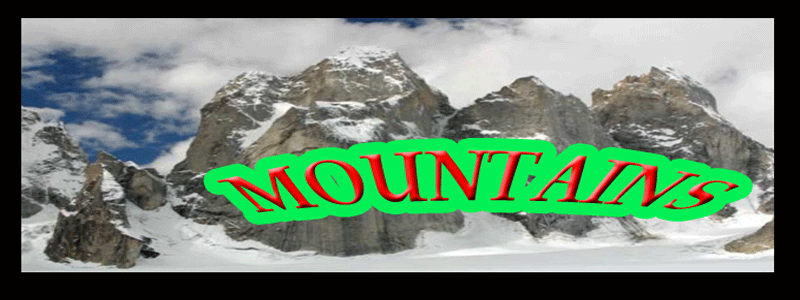The Sulaiman Mountains or Koh-e Sulaimān are a major geological feature of eastern and southeastern Afghanistan (Zabul, most of Loya Paktia and northeastern Kandahar), and South Waziristan, most of northern Balochistan Province and some of southwestern Punjab Province of Pakistan.

The Sulaiman Mountains form the eastern edge of the Iranian plateau where the Indus River separates it from the Indian Subcontinent. Bordering the Sulaiman Range to the north are the arid highlands of the Hindu Kush, where more than 50 percent of the lands lie above 2,000 meters.
In Balochistan, the most famous peaks of the Sulaiman Mountains are Takht-e-Sulaiman (3,487 meters), Taunsa Sharif, the Khilafat Hills (3,475 meters) in Ziarat, Kesai Ghar (3,444 meters) near Zhob and Zarghun Ghar (3,578 meters) near Quetta.
Rivers that flow from the Sulaiman mountain range include the Dori River and the Gomal River. Takht-e-Sulaiman at 3,487 metres (11,440 ft), Koh-i-Takatu at 3,472 metres (11,391 ft), the Kesai Ghar at 3,444 metres (11,299 ft) and Giandari are some of the mountain peaks in the Sulaiman range.
The Sulaiman range runs north in Loya Paktia and meets the Spin Ghar range northeast of Gardez in Paktia province. To the east, the mountain range enters the districts of Dera Ghazi Khan (in Punjab) and Dera Ismail Khan (in Khyber Pakhtunkhwa), and approaches the Indus River near Mithankot in the Rajanpur District of Punjab. The eastern slopes drop very quickly to the Indus River, but towards west, the mountain range drops gradually to the Sistan Basin.
The Sulaiman Range and the high plateau to the west of it, helps form a natural barrier against the humid winds that blow from the Indian Ocean, creating arid conditions across southern and central Afghanistan to the west and north. In contrast, the relatively flat and low-lying Indus delta is situated due east and south of the Sulaiman Mountains. This lush delta is prone to heavy flooding and is mostly uncultivated wilderness.
Vegetation is scarce in the southern slopes. In the central part, wild olives are abundant, and especially in river valleys, there is a high diversity of flora, including ephedra, pistachios and orchards of apples and cherries, as well as wild almonds and junipers. Ziarat District is a tourist destination, famous for its large Pashtun Juniper (juniperus macropoda) forests. Further to the northwest near the Koh-i-Baba mountain range, the higher altitudes of the Sulaiman Mountains are in alpine meadow ecoregion, characterized by meadows and willows, as well as blue pines which cover the summits.
In an Afghan legend, one of the highest peaks of the Takht-i Sulaiman ("Throne of Solomon"), 3,382 metres (11,096 ft) high, is associated with Prophet Solomon. Ibn Battuta names it Koh-i Sulaiman.[2] It is related that Prophet Solomon climbed this mountain and looked out over the land of South Asia, which was then covered with darkness, but he turned back without descending into this new frontier, and left only the mountain which is named after him (from Ibn Battuta). According to another legend, Noah's Ark alighted in the Takht-i Sulaiman after the Deluge.
Legend says that Qais Abdur Rashid, said to be the ancestor of the Pashtun nation, is buried on top of the Kesai Ghar ("Mount of Qais"), located near the village of Darazinda in Frontier Region Dera Ismail Khan of the Federally Administered Tribal Areas, close to the border with the Zhob District of Balochistan. Some people visit the place and make animal sacrifices, usually a sheep or a goat, at the tomb of Qais as to help feed the poor. A trip to the mountain is undertaken mostly in summer, since from late November until March the snowfall makes it difficult to climb. Nearly all major Pashtun tribes are said to be the progeny of his sons and daughters.









